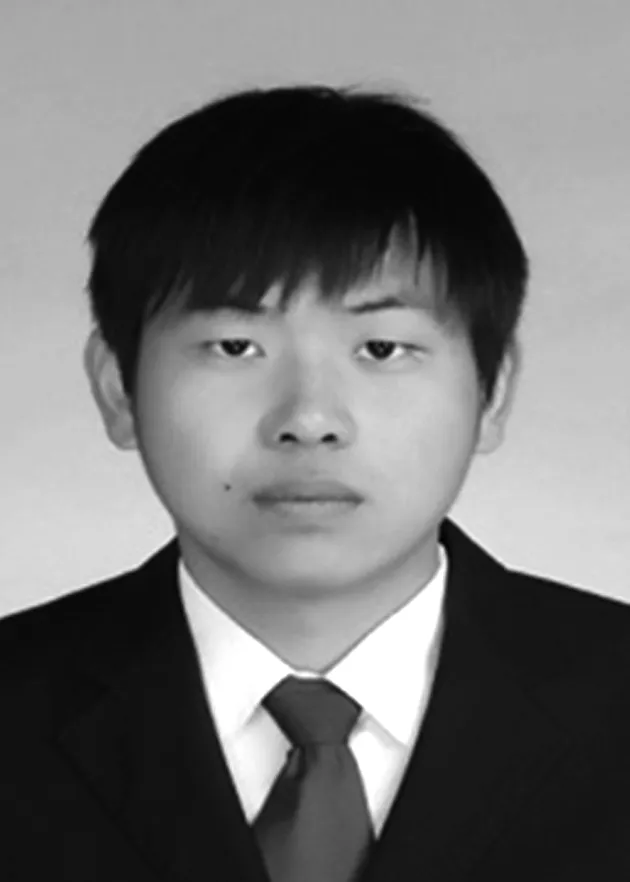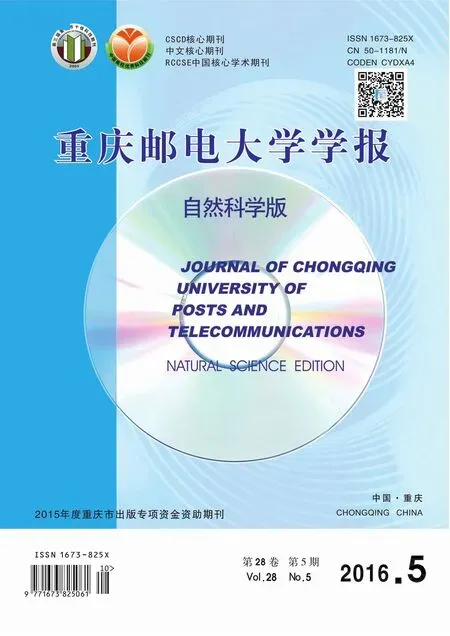An effective method of reducing PAPR in FBMC system with carrier aggregation
ZHUANG Ling, WENG Haitao, WANG Guangyu
(Chongqing Key Laboratory of Mobile Communication, Chongqing University of Posts and Telecommunications, Chongqing 400065, P.R. China)

An effective method of reducing PAPR in FBMC system with carrier aggregation
ZHUANG Ling, WENG Haitao, WANG Guangyu
(Chongqing Key Laboratory of Mobile Communication, Chongqing University of Posts and Telecommunications, Chongqing 400065, P.R. China)
In order to solve the much high PAPR(peak to average power ratio) problem in FBMC(filter bank multicarrier) system with carrier aggregation, this paper presents an improved method based on tone reservation (TR) to reduce PAPR in this system. Rather than applying the valid data subcarriers traditionally, we take the guard band (GB) subcarriers between component carriers (CC) in carrier aggregation utilized as the reserved subcarriers, which are filled with redundant data to reduce PAPR. To minimize the impact of overlapping factor, backward superimposition process between symbols is also used in this method against the regrowth of PAPR caused by the overlapping structure of symbols, which means that the signal is divided into different groups and each group completed will be added to next one for processing. Simulation results show that this method presented effectively improves the PAPR performance without affecting the basic transmission performance.
filter bank multicarrier;carrier aggregation;peak to average power ratio;tone reservation
Article ID:1673-825X(2016)05-0713-08
1 Introduction
As a candidate multi-carrier modulation technique for 5G mobile communication system, filter bank multicarrier (FBMC) has many advantages relative to orthogonal frequency division multiplexing (OFDM) used in current LTE system. FBMC is based on non-rectangular pulse of subcarrier forming[1-3], which adopts optimized prototype filter to accelerate the band attenuation to overcome the sensitivity of the frequency offset. Furthermore, FBMC does not need CP, which in many cases improves the spectrum utilization.
The requirement of lager bandwidth and higher peak rate is the main driving force of carrier aggregation (CA) in E-UTRAN. In order to meet the requirement of larger bandwidth in LTE-A system, 3GPP proposed the carrier aggregation technology in Release 10[4]. By increasing the access bandwidth indirectly, system capacity and peak rate are improved by carrier aggregation.
With the requirement of much higher peak rate in 5G mobile communication system, spectrum aggregation or carrier aggregation technology is also a candidate solution[5]. Therefore, we introduce carrier aggregation into FBMC modulation system in this paper. As a kind of multi-carrier system, FBMC system is also confronted with the PAPR problem inevitably[6]. What’s more, multiple component carriers in carrier aggregation will make the PAPR performance to be further deteriorated[7-8].
There are few methods of reducing PAPR in the FBMC system at present. Alexandre Skrzypczak et al proposed the OSLM (overlapped SLM) method to reduce PAPR of the FBMC system based on the SLM method applied in the OFDM system in[9]. Krishna Chaitanya Bulusu et al in[10] proposed a scheme named as dispersive selective mapping (DSLM), which is an extended and generalized version of overlapped selective mapping (OSLM), and it still need too many times of searching to obtain a better PAPR performance. M.U. Rahim et al in[11] analyzed the clipping method applied in FBMC system to reduce PAPR, which indicates that the sidelobe of the spectrum would be significantly affected and the BER(bit error ratio) performance of the FBMC system would be greatly impacted. By analyzing the feature of FBMC symbols, the effect of the method on BER performance should be made into consideration significantly. That is to say, it is necessary to avoid the influence on the characteristics of low sidelobe in the FBMC system when PAPR is reduced.
This paper presents an improved method based on tone reservation for reducing PAPR,which is suitable for the FBMC system with carrier aggregation. Because the guard band between component carriers is available to use in carrier aggregation, we take the guard band (GB) subcarriers between component carriers in carrier aggregation to be utilized as the reserved subcarriers. Redundant data is filled into these guard subcarriers to adjust the phase of symbols for reducing PAPR. For the feature of overlapping between symbols in the FBMC system with carrier aggregation, PAPR will regrow if symbols are processed separately like OFDM. Therefore, backward superimposition processing between symbols is also taken in this method to avoid the regrowth of PAPR in this system.
2 System model
This section will introduce the basic framework of FBMC system, the signal model of transceiver, the way to implement carrier aggregation respectively.
2.1FBMC transceiver
The FBMC modulation system is mainly composed of the synthesis filter bank (SFB) and analysis filter bank (AFB), the structure[12]is as shown in Fig.1.

Fig.1 Filter bank multicarrier modulation system

(1)

(2)
The signal obtained by processing of AFS in receiver is expressed as
(3)
2.2Implementation mode of carrier aggregation
According to different spectrum scenarios, two basic implementation methods of carrier aggregation in physical layer are as follows[13]:
1)For the easy scalability of IFFT(inverse fast Fourier transform), bandwidth of system is extended by large IFFT/FFT module. This method is suitable for carrier aggregation of intra-band, because the points of IFFT can’t be too large in reality. What’s more, for the carrier aggregation with non-contiguous component carriers in the same frequency band, some blank subcarriers should be reserved in the IFFT/FFT module.
2) Modulation on each component carrier could be implemented with each IFFT/FFT module independently. This scheme has more flexibility, but the disadvantage is that a larger number of IFFT/FFT modules are needed. Meanwhile, wireless channel characteristics such as path loss and Doppler frequency shift have different effect on different frequency band, so multiple RFs is needed. This is a disadvantage for the complexity and cost of implementation.
It is necessary to point out that the implementation of carrier aggregation is similar between OFDM and FBMC system. The only difference is the IFFT/FFT modules in OFDM system should be transformed into the SFB/AFB modules in FBMC system. This paper makes research on continuous band carrier aggregation in FBMC system.
3 PAPR of FBMC modulation system with carrier aggregation
For the existence of overlapping factorK, the symbols of FBMC with carrier aggregation are overlapped in time domain. So the definition of PAPR in this modulation system can't use the definition existed in OFDM system. A new definition of PAPR in FBMC system with carrier aggregation will be introduced next.



(4)
wherel=0,1,…,K+L-1.
Two component carriers in carrier aggregation is assumed in this paper, and the corresponding signal processing by the SFB module of FBMC system with carrier aggregation areS1(n) andS2(n). The output signal of the system is as follows:
(5)
The PAPR of the FBMC system with carrier aggregation is expressed as

lM≤n≤lM+M-1
(6)
wherel=0,1,…,K+L-1,|S1(n)+S2(n)| represents the amplitude of the transmitted signal of FBMC system with carrier aggregation, max{·} indicates the maximum value andE{·} represents the expectation value of the signal in each interval. The expression of PAPR in dB is defined by
PAPR(l)dB=10log(PAPR(l))
(7)
wherel=0,1,…,K+L-1.
The cumulative complementary distribution function (CCDF) is an established method to PAPR in multicarrier systems[14]. It is defined as the probability of the PAPR in each symbol interval in FBMC system with carrier aggregation which exceeds a given thresholdγ:
CCDF[PAPR(l)]=Pr(PAPR(l)>γ)
(8)
For the existence of overlapping factor, FBMC symbols are overlapped with each other. If the PAPR reducing processing is completed in each block separately, the peak value of power will regrow again when the symbols are overlapped. Therefore, traditional methods for reducing PAPR used in OFDM system are not suitable for FBMC system with carrier aggregation. Furthermore, carrier aggregation increases the number of subcarriers in multicarrier system essentially, which makes PAPR of the system deteriorated. Therefore, an effective method to reduce PAPR in the CA-FBMC system is proposed in this paper.
4 An improved method to reduce PAPR for FBMC system with carrier aggregation
This section presents an effective method of tone reservation for reducing PAPR in FBMC modulation system with carrier aggregation. Guard subcarriers between two component band carriers are acted as reserved subcarriers. Filling redundant data in reserved subcarriers and iteration clipping with backward superimposition are also used in this method. According to Fig.2, this method is described in this section.

Fig.2 Description to the improved algorithm for FBMC system with carrier aggregation

(9)
whereRD1andRD2represent the set of data subcarriers in band 1 and 2 of the system respectively, andRCrepresents the set of reserved subcarriers to generate peak canceling signal.
Thelthdata block of valid subcarriers for users which is composed of band 1 and band 2 is send to SFB module, and the corresponding output signal issl(n), i.e.
(10)
wheren∈[0,(K+1/2)M-1] andKrepresents the overlapping factor.


(11)
(12)


(13)
So the signalfl(n) to be clipped down from the original signal can be expressed as
(14)
wheren∈[0,(K+1/2)M-1].
Since the clipping only relates to the firstMsignal points of the symbol interval, sofl(n)=0, wheren∈[M,M+1,…,(K+1/2)M-1].
Signalfl(n) is sent into AFB module of system to obtain the data F(l) in frequency domain, where F(l)=[F0(l),F1(l),…,FM-1(l)]. Keep the data F(l) on the reserved subcarriers to be multiplied by the Amplification factorαand the data F(l) on other subcarriers are replaced by zero, so the signalCk(l) in frequency domain is obtained as follows, i.e.
(15)
(16)


(17)
wheren∈[0,(K+1/2)M-1].
It is necessary to point out that,the data of each block on the reserved subcarriers is set to be zero initially.
From the description of the method proposed,the specific procedure is as follows:
Step 1Determine the basic parameters, including the component carrier bandwidth, the guard bandwidth, the type of prototype filterh(n), the amplification factorα, the clipping factorwand the number of iterationP, the default value ofPAPR0. The number of data blocks is set to beLands0(n)=0Twithlengthof(K+1/2)M .setl=1;


Step 4fl(n) is sent into AFB module to obtain the frequency symbol F(l). Let F(l)corresponding to the reserved subcarriers (guard bandwidth) multiplied by the amplification factorα, the F(l) in other subcarriers position is set to zero, and assigns it as C(l);
Step 5D1(l), D2(l) and C(l) are sent into SFB module, and updatessl(n). Calculate the PAPR for the firstMsignal points ofsl(n);
Step 6Make a comparison between PAPR calculated in Step 5 and PAPR0. If PAPR0 is less than the PAPR value, jump to Step 8;
Step 7Estimate whether the number of iterations completedpis less than the number of iterationPinitially, ifp Step 8Record the data D1(l),D2(l),C(l) andsl(n); Step 9Estimate whetherlis up to the number of data blockL, ifl Step 10End the algorithm. According to procedure of the algorithm, we can derive the complexity of this algorithm. The number of data blocks isLand the number of iteration times isP. Thelthdata block D1(l), D2(l), …,DN(l) represents data on each component carrier, whereNrepresents the number of component carrier. In this algorithm, data block on each component carrier need one times processing of SFB and AFB in each time of iteration and the complexity of SFB is the same as AFB. Therefore, it will need 2×L×P×Ntimes processing of SFB module. When the complexity of SFB module is defined asO(1), the complexity of this algorithm isO(L×P×N). To evaluate the performance of the proposed method, the simulation results are presented in this section. The specific simulation parameters are shown in Tab.1. Tab.1 Simulation Parameters To evaluate the performance of the algorithm, three aspects including PAPR, average power of symbol and system BER performance by the processing of the algorithm proposed are simulated respectively. The comparison between original PAPR and the ones with different iteration numbers in this algorithm is shown in Fig. 3 by using CCDF. Fig.3 PAPR in different iteration times As is shown in Fig. 3, whenCCDF=10-3and the numbers of iteration are 3, 6 and 9 times, the performance gain of PAPR can be obtained with 1.5 dB, 2.1 dB and 2.3 dB respectively. With the increment of the iteration number, performance gain of PAPR is increased, but the increasing rate of the PAPR performance gain decreases. That is to say, with the increment of the iteration numbers, PAPR performance gain of the system begins to converge. To evaluate that reduction of peak value of symbol plays a definitely great part in the reduction of PAPR by using the proposed method, here comes a comparison of the variety rate about the average power with different iteration numbers. As is shown in Fig.4, average power of symbols in each interval increases slightly with the increment of iteration numbers. The increment is about 0.15 dB, compared with the original average power. According to the definition of PAPR in section 3, the variety of average power is quite small relative to the level of decrement in PAPR. That is to say, peak power reduction of signal plays a leading role in the decrement of PAPR, which evaluates that the proposed method can effectively reduce the peak power of the system. Fig.4 Variance rate of average power(dB) in different iteration times To evaluate the influence of the filled data in reserved carriers on transmission, the BER performance is presented here. The channel is multi-path channel provided by 3GPP TS 25.104 and simple ZF equilibrium is utilized. The simulation results of BER with different iteration times are shown in Fig.5. As is shown in Fig.5, the BER performance with different iteration times are basically the same as the original one. The reason is that the proposed algorithm does not change the symbol value in data subcarriers, and the value of data filled in the guard subcarriers is so small that the influence to the data subcarriers for users can be almost ignored actually. Fig.5 16QAM BER performance with different iteration times. The simulation results evaluate that the proposed method can effectively reduce the PAPR of this system without affecting to the BER performance, which proves the effectivity of this proposed method. An effective method based on tone reservation for reducing PAPR in CA-FBMC system is presented in this paper. The guard subcarriers between component carriers are applied as reserved subcarriers to reduce PAPR. For the structure of overlapping between symbols in this system, we take the backward superimposition processing in the method proposed against the regrowth of PAPR. The simulation results indicate that performance gain of PAPR is improved effectively with several iteration times, and the BER performance are basically the same as original one, which proves the effectivity of this method. [1]FARHANG-BOROUJENY B. OFDM versus filter bank multicarrier [J].IEEE Signal Processing Magazine, 2011, 28(3): 92-112. [2]SCHAICH F, WILD T. Waveform contenders for 5G — OFDM vs. FBMC vs. UFMC[C] ∥2014 6th International Symposium on Communications, Control and Signal Processing. [s.l.]: IEEE, 2014: 457-460. [3]谢显中. 第5代移动通信基本要求与新型多址复用技术[J].重庆邮电大学学报:自然科学版,2015,27(4):434-440. XIE Xianzhong. Key requirements and multi-access multiplexing techniques for 5G[J]. Journal of Chongqing University of Posts and Telecommunications: Natural Science Edition, 2015, 27(4):434-440. [4]3GPP RP-091440.Work item description: carrier aggregation for LTE[S]. [s.l.]:3GPP, 2009. [5]BOGUCKA H, KRYSZKIEWICZ P, KLIKS A. Dynamic spectrum aggregation for future 5G communications[J]. IEEE Communication Magazine, 2015, 53(5): 35-43. [6]PHYDYAS:Physical layer for dynamic access and cognitive radio[EB/OL].[2015-04-21].http:∥cordis.europa.eu/pub/fp7/ict/docs/future-networks/projects-phydyas-factsheet_en.pdf. [7]ZHANG Shaoxin, ZHOU Jun, ZHU Hongbo, et al. Cubic metric improvement of aggregated carriers for downlink transmission in LTE-advanced[J]. The Journal of China Universities of Posts and Telecommunications, 2011, 18(1): 60-63. [8]ZHOU Yiqing, PAN Zhengang. CM/PAPR reduction for LTE-A downlink with carrier aggregation. U.S. 0261676 [P]. 2011-02-12. [9]SKRZYPCZAK A, SIOHAN P, JAVAUDIN J P. Reduction of the peak-to-average power ratio for OFDM-OQAM modulation[C]∥Proceeding of the International Conference on Vehicular Technology. Melbourne, Vic: IEEE, 2006:494-499. [10] BULUSU K C, SHAIEK H, ROVIRAS D, et al. Reduction of PAPR for FBMC-OQAM systems using dispersive SLM technique[C]∥Proceeding of the International Symposium on Wireless Communications Systems. Barcelona: IEEE, 2014:568-572. [11] RAHIM M U, STITZ T H, RENFORS M. Analysis of clipping-based PAPR-reduction in multicarrier systems[C]∥Proceeding of the International Conference on Vehicular Technology. Barcelona : IEEE, 2009:1-5. [12] VIHOLAINEN A, BELLANGER M, HUCHARD M. ICT-211887, PHYDYAS D5.1. WP5: prototype filter and filter bank structure[S]. [s.l.]:[s.n.], 2009. [13] YUAN Guang-xiang, ZHANG Xiang, WANG Wen-bo, et al. Carrier aggregation for LTE-advanced mobile communication systems[J]. Communications Magazine, IEEE, 2010, 48(2): 88-93. [14] N. van der NEUT, MAHARAJ B T, de Lange F H, et al. PAPR reduction in FBMC systems using a smart gradient-project active constellation extension method[C]∥2014 21st International Conference on Telecommunications. Lisbon: IEEE, 2014: 134-139. Biographies: ZHUANG Ling(1978-), female ,comes from Chongqinq. She is an Associate Professor of Chongqing University of Posts and Telecommunications, China. Her main research interests are multicarrier modulation technique for mobile communication, multi-rate digital signal processing and filter bank theory, and related topics. E-mail: Zhuangling@cqupt.edu.cn. WENG Haitao(1988-), male, comes from Anhui Province. He is an MSc student at Chongqing University of Posts and Telecommunications. His research interests are multicarrier modulation techniques for mobile communication and filter bank theory. E-mail: 806107807@qq.com. WANG Guangyu(1964-), male, comes from Guizhou Province. He is a Professor of the College of Communication and Information Engineering, Chongqing University of Posts and Telecommunication, and a researcher at the Lab of Mobile Communication Technology. His main research interests include high-speed signal processing and multi-rate filter bank theory. (编辑:魏琴芳) 2015-09-29 2016-06-12通讯作者:翁海涛806107807@qq.com 一种基于预留子载波的CA-FBMC系统PAPR抑制算法 庄陵,翁海涛,王光宇 (重庆邮电大学 重庆移动通信重点实验室, 重庆 400065) 针对引入载波聚合的滤波器组多载波(carrier aggregation-filter bank multicarrier,CA-FBMC)调制系统峰均功率比(peak to average power ratio,PAPR)进一步升高的问题,基于预留子载波(tone reservation,TR)思想,提出一种适用于面向载波聚合的FBMC(filter bank multicarrier)系统降低PAPR的有效方法,利用分量载波间原有保护子载波充当预留子载波成分,结合时域信号剪切的处理方法,在不改变原有信号子载波有效输入数据的前提下,降低系统信号的PAPR。同时,由于重叠因子的存在,为克服系统符号重叠特性的影响,利用后向迭代的处理思想,对时域输出信号进行分组,针对每组信号分别进行迭代剪切处理,并将处理完成的信号进行后向叠加处理,从而避免符号重叠引发的峰值增生而导致PAPR回退的问题。仿真结果表明,该算法可在不影响系统基本传输性能的情况下有效降低系统的PAPR。 滤波器组多载波(FBMC);载波聚合;峰均功率比(PAPR);预留子载波 10.3979/j.issn.1673-825X.2016.05.016 The Scientific and Technological Research Program of Chongqing Municipal Education Commission(KJ1500435) TN929.5Document code:A5 Simulation results
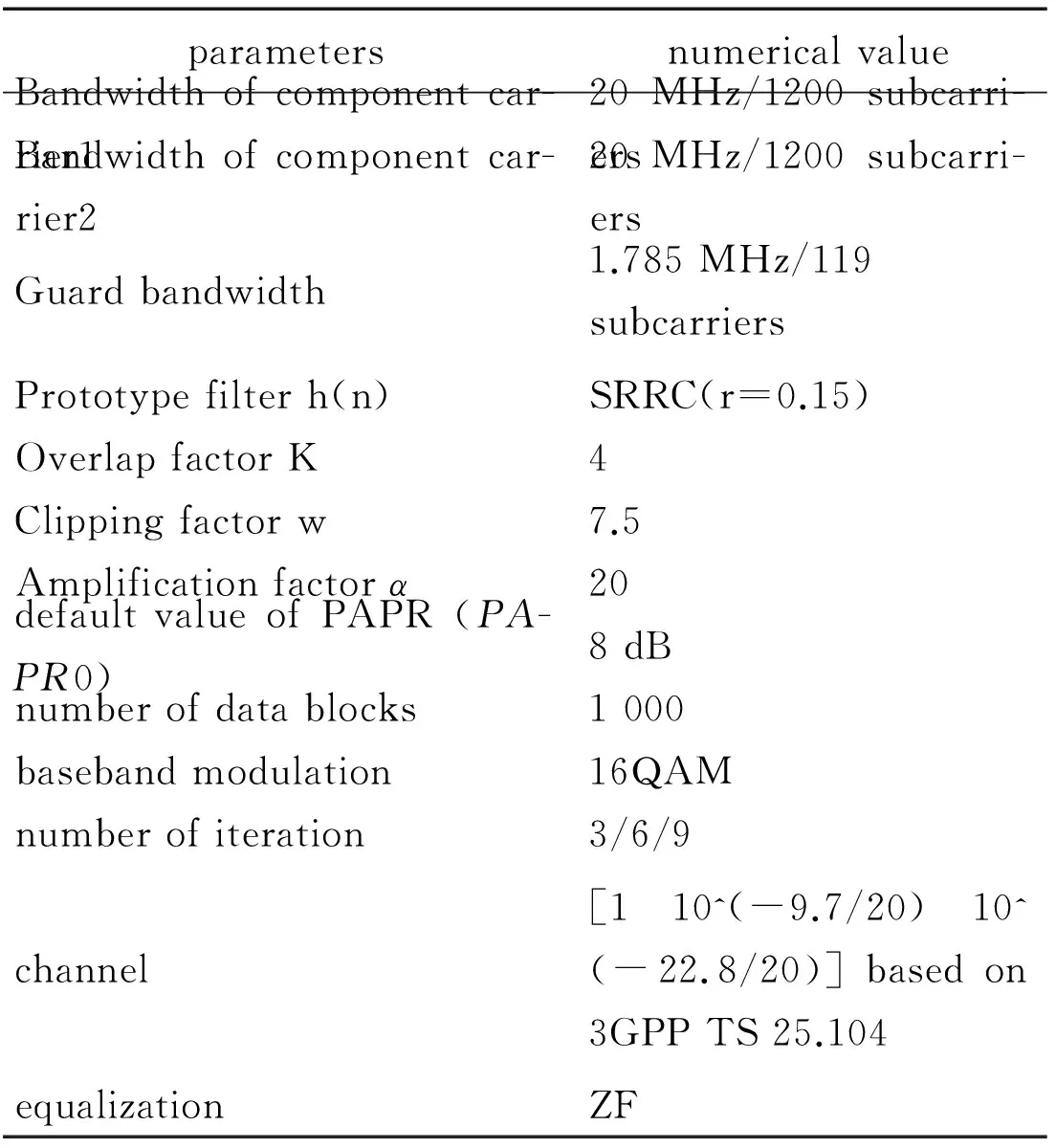

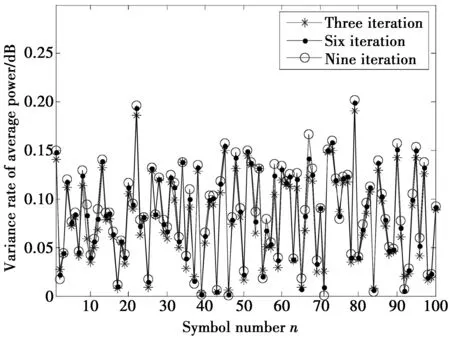
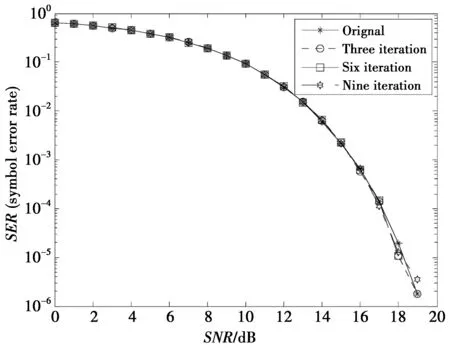
6 Conclusions

